Nestled in the heart of the Sangre de Cristo Range lies Wheeler Peak, the tallest mountain in New Mexico. This majestic peak, standing at a towering height of 13,167 feet, boasts an incredible diversity of wildlife that attracts nature lovers and hikers from all around the globe. The biodiversity in this region is truly astounding, with a multitude of species that have adapted to the alpine conditions. From the smallest insects to the most majestic birds and mammals, each creature plays a vital role in maintaining the balance of this unique ecosystem. Let’s dive in and discover the animals that live atop New Mexico’s tallest mountain!
Overview of New Mexico’s Tallest Mountain

Wheeler Peak is the tallest mountain in New Mexico.
©Elijah Beck/Shutterstock.com
Wheeler Peak is a part of the larger Wheeler Peak Wilderness area, which covers an expansive 19,000 acres. The mountain’s unique features include stunning glacial cirques, lush meadows, and glistening alpine lakes. The high altitude and cold weather create a unique habitat that supports diverse vegetation and wildlife.
The weather atop Wheeler Peak varies greatly throughout the year, with temperatures often dipping below freezing during winter months. Despite these harsh conditions, the vegetation is surprisingly diverse, providing a rich habitat for numerous animals. You’ll find dense forests of Engelmann spruce and subalpine fir at lower elevations, while alpine tundra dominates the highest reaches.
The Mammals
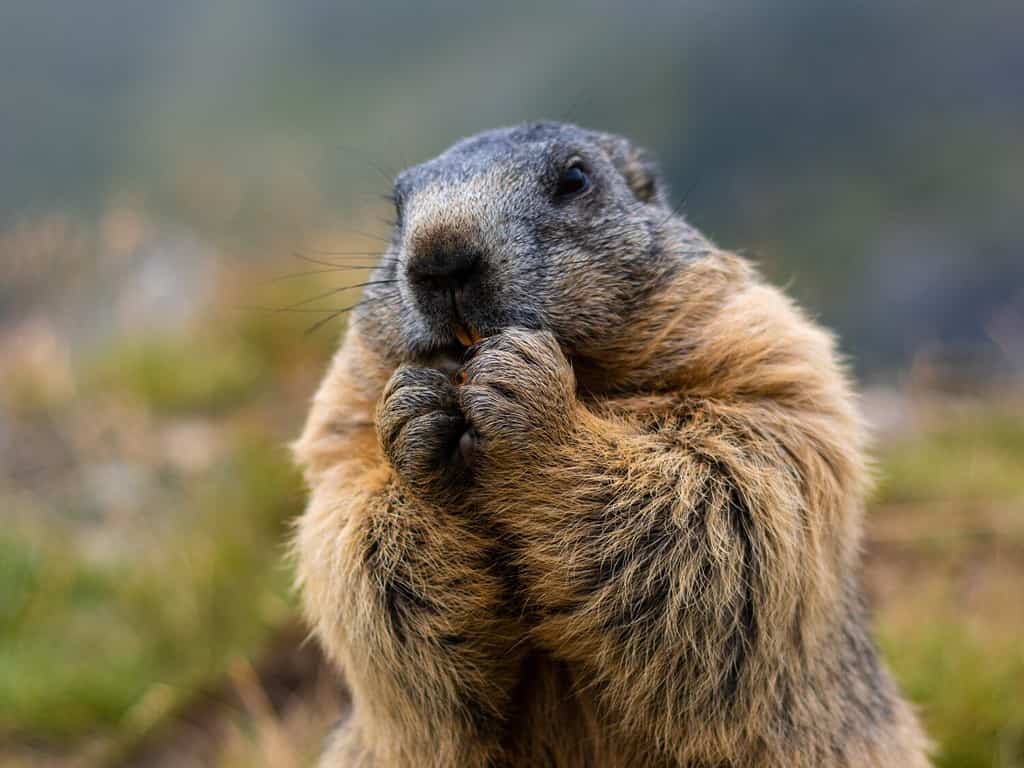
Pikas and marmots are common animals to see atop New Mexico’s tallest mountain.
©jan ptacek/Shutterstock.com
Pika
The pika is a small mammal resembling a rabbit with rounded ears. They thrive in cold climates and are commonly found in rocky areas of Wheeler Peak. Pikas mainly eat grasses and herbs during the summer and store food for winter in their burrows.
If you remain still, you may even catch a glimpse of a pika. It appears similar to a rabbit without a tail. Pikas belong to the rabbit family and spend their summer gathering “hay” to store and eat during the long winter months. They don’t hibernate.
Marmot
Marmots are large ground squirrels known for their distinctive whistling song. They are herbivorous creatures that live in burrows on rocky slopes and feed on leaves, flowers, and grasses. Marmots hibernate during winter and are most active during warm summer months.
Marmots, otherwise known as ‘whistling pigs,’ can be seen scurrying around on the rocky slopes of New Mexico’s highest mountain. They make a unique and loud whistling sound to alert other marmots of potential danger. Marmots are true hibernators, sleeping for eight months out of the year. They are only active for four months in the summertime to feed on grass and other vegetation.
Elk
Elk, scientifically known as Cervus canadensis, are majestic creatures that belong to the deer family. They are native to North America. Referred to as one of the largest species of deer, these magnificent animals have captured the imagination of nature enthusiasts across the continent.
As herbivores, elk sustain themselves by grazing on a diverse array of vegetation, including grasses, plants, leaves, and bark. Their diet consists of nutrient-rich forage, which allows them to thrive in various habitats. They range from meadows and forests to mountainous regions.
One remarkable aspect of elk is their highly social nature. These gregarious animals typically live in herds or groups known as “wapiti” – a Native American term meaning “white rump.” Within these herds, there is usually a dominant male. He is called a bull, and he leads and protects his group during mating season while showcasing his impressive antlers.
Mule Deer
Mule deer, renowned for their distinctively large mule-like ears, thrive in the diverse forested areas of Wheeler Peak. With their elegant and graceful presence, these magnificent creatures have gained prominence as one of the most prevalent species on this majestic mountain.
As herbivores, mule deer possess a versatile palate. This allows them to feast upon an array of vegetation found within their habitat. From vibrant wildflowers known as forbs to robust shrubs and luscious grasses, they take advantage of every available food source. Their adaptability even extends to consuming succulent leaves from towering trees that grace the landscape.
These remarkable creatures navigate through the dense foliage with nimbleness and agility. They make use of their keen senses to detect the freshest patch of greenery or the tastiest browse nearby. They gracefully move among the trees and underbrush while selectively nibbling on various plants throughout each day.
The Birds
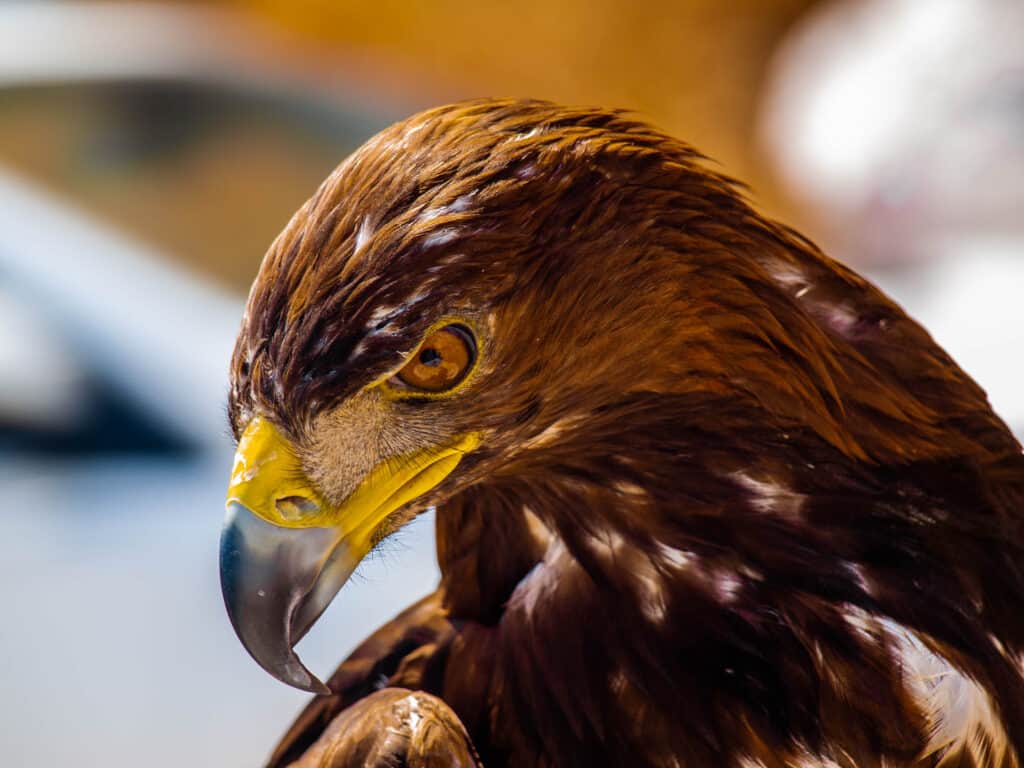
Golden eagles are one of the top predatory animals atop New Mexico’s tallest mountain.
©elmehdi.ph/Shutterstock.com
Golden Eagle
Aquila chrysaetos, or golden eagles, majestic creatures of the skies, hold a prominent place among North America’s avian residents. With their awe-inspiring wingspan and resplendent golden-brown plumage, these formidable birds command attention wherever they soar. They nestle high atop cliffs or perch atop lofty trees. They construct vast nests that serve as both sanctuaries and vantage points for their hunting endeavors.
Inhabiting the great heights of New Mexico’s tallest mountain range, golden eagles exhibit unparalleled prowess in capturing prey. Their diet mainly consists of small mammals such as rodents and rabbits. These small animals fall victim to their razor-sharp vision and extraordinary agility. These masterful predators are known to swoop down from dizzying heights. They use astonishing speed and precision when seizing their unsuspecting quarry.
Endowed with acute eyesight that can spot a potential meal from miles away, golden eagles prove themselves as masters of navigation across vast landscapes. They expertly navigate through rugged terrains using thermal updrafts to effortlessly glide through the air currents while scanning the terrain below for any sign of movement or life.
Magpie
Magpies are known for their striking black-and-white plumage and elongated tails. They are highly intelligent birds that captivate the attention of nature enthusiasts. Found atop New Mexico’s tallest mountain, these avian creatures showcase a diverse palate as they indulge in a wide range of foods to sustain themselves. They eat delectable insects and nourishing seeds. They also enjoy succulent berries and even carrion. Magpies exhibit remarkable adaptability when it comes to satisfying their dietary needs.
In addition to their eclectic diet, another fascinating aspect of magpie behavior lies in their architectural prowess. These resourceful birds construct impressive abodes. They make large domed nests perched gracefully on trees or nestled amidst bushes. Their meticulous construction skills ensure not only comfort but also provide a safe haven for raising their young ones.
Canada Jay
Canada jays, also known as grey jays or whiskey jacks, are charismatic and friendly birds. They can often be spotted at campgrounds in the stunning wilderness of New Mexico’s tallest mountain. These intelligent birds have carved out a niche for themselves by scavenging for food scraps left behind by campers.
While their diet is diverse, Canada jays primarily rely on insects, juicy berries, nutritious fungi, and even small rodents to sustain themselves throughout the year. Their resourcefulness allows them to adapt to various habitats within the mountainous landscape of New Mexico.
During colder months, when winter blankets the region with freezing temperatures and heavy snowfall, Canada jays display remarkable survival strategies. They skillfully build nests high up in coniferous trees using twigs and other natural materials. This not only provides them shelter but also offers protection against the harsh elements that come hand-in-hand with frigid winters.
Chickadee
Chickadees are delightful small birds with cheerful songs and acrobatic flying skills. They are a true delight to behold atop New Mexico’s tallest mountain. These charming creatures not only captivate us with their melodious tunes but also showcase their impressive aerial maneuvers as they gracefully soar through the skies.
While insects make up the primary diet of these dainty birds. But, it is worth noting that chickadees possess a diverse palate. They take pleasure in feasting on an assortment of seeds and berries found amidst the breathtaking landscape of New Mexico’s majestic peak. Whether it be delectable sunflower seeds or succulent wild berries, these resourceful avian wonders have mastered the art of foraging and savoring nature’s offerings.
When it comes to seeking shelter and creating a safe haven for their young ones, chickadees ingeniously choose tree cavities. Some pick cozy birdhouses nestled within the enchanting forests that adorn this magnificent mountainous region. Their nesting habits reflect not only their adaptability but also highlight their preference for secure yet well-hidden abodes where they can raise future generations amidst the tranquility of nature.
Lewis’s Woodpecker
Lewis’s woodpecker, scientifically known as Melanerpes lewis, is a striking bird. It captivates us with its distinctive green-black body and vibrant red face. This unique combination of colors sets it apart from other woodpecker species found in the wilds of New Mexico’s tallest mountain.
Renowned for its diverse diet, Lewis’s woodpecker showcases remarkable adaptability when it comes to sustenance. Insects form the primary source of nourishment for this avian marvel. It also relishes indulging itself with an assortment of fruits and nuts. This versatility in dietary choices allows the Lewis’s woodpecker to thrive even amidst changing environmental conditions or seasonal fluctuations.
The Reptiles
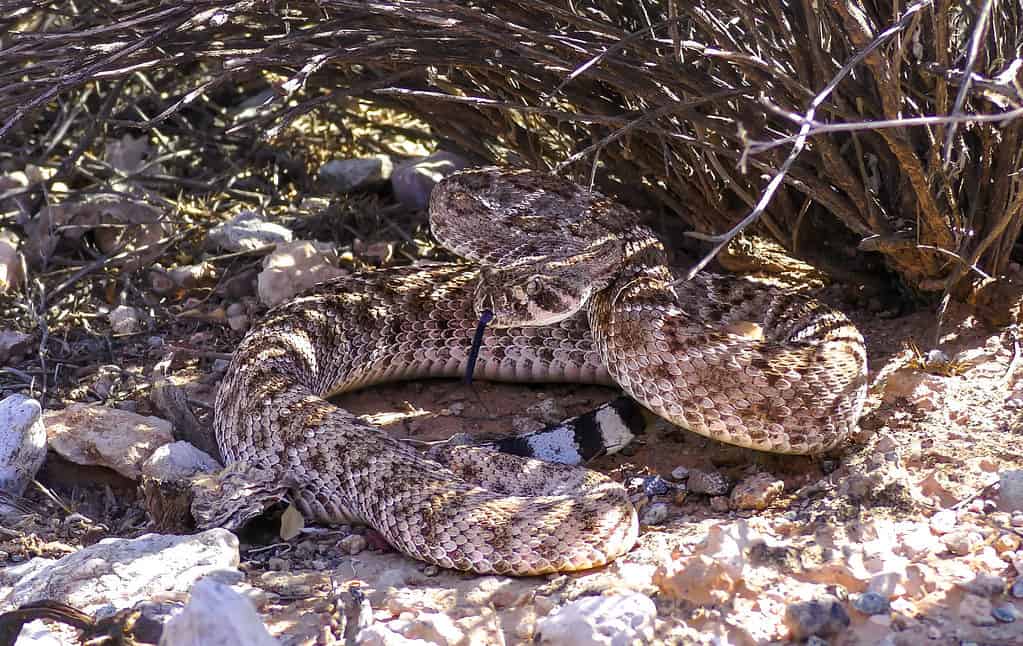
Western diamondback rattlesnakes live in warm, rocky outcroppings atop New Mexico’s tallest mountain.
©iStock.com/Banu R
Western Diamondback Rattlesnake
The western diamondback rattlesnake is a prominent inhabitant of New Mexico’s diverse wildlife. It commands attention as one of the most formidable and perilous snakes within the region. It is renowned for its distinct diamond-shaped patterns adorning its sleek body. This venomous creature strikes an imposing figure against the rugged landscapes it prowls across. It draws both awe and fear from those who encounter it. The western diamondback rattlesnake possesses a notorious reputation that underscores its unparalleled danger.
Beyond its striking appearance lies a defining characteristic that sets this serpent apart. The iconic rattle at the tip of its tail! It rattles a symphony of warnings to potential adversaries or unsuspecting passersby. This unique adaptation serves as an auditory alarm system signaling imminent danger. With each movement producing a chilling cascade of rapid vibrations, the rattling tail acts as an unmistakable signal to heed caution and steer clear.
Native to New Mexico’s untamed wildernesses, these resilient predators skillfully navigate their natural habitats with stealthy grace. Their adaptability enables them to thrive in various environments. They range from arid deserts to rocky terrains prevalent in mountainous regions like New Mexico’s tallest peaks. Here amidst nature’s grandeur, where jagged cliffs meet endless skies, and winds whisper secrets through towering pines, these serpents confidently assert their presence atop these majestic summits.
New Mexico Whiptail Lizard
The New Mexico whiptail lizard, designated as the official state reptile of its namesake state, is a captivating creature that effortlessly captures the attention of wildlife enthusiasts. This remarkable reptile stands out not only for its distinctive title but also for its visually striking features. With a sleek and slender body, the New Mexico whiptail lizard boasts an elegant physique that gracefully glides across the rugged terrain of its native habitat.
One cannot help but be captivated by the intricate pattern adorning this enchanting lizard’s exterior. Sporting seven vibrant yellow stripes that stretch seamlessly from head to tail, it presents a mesmerizing sight that adds an alluring charm to their already beguiling appearance. These resplendent markings serve both practical and aesthetic purposes in the life of this fascinating species.
Intriguingly enough, these yellow stripes are not merely for show. They play a crucial role in distinguishing individuals within their population and aiding in communication amongst conspecifics. Through subtle variations in stripe patterns or slight deviations in hue intensity, each New Mexico whiptail lizard showcases unique characteristics that set them apart. This distinctiveness allows fellow lizards to identify one another amidst sprawling landscapes and fosters social bonds among members of this intriguing species.
The Insects
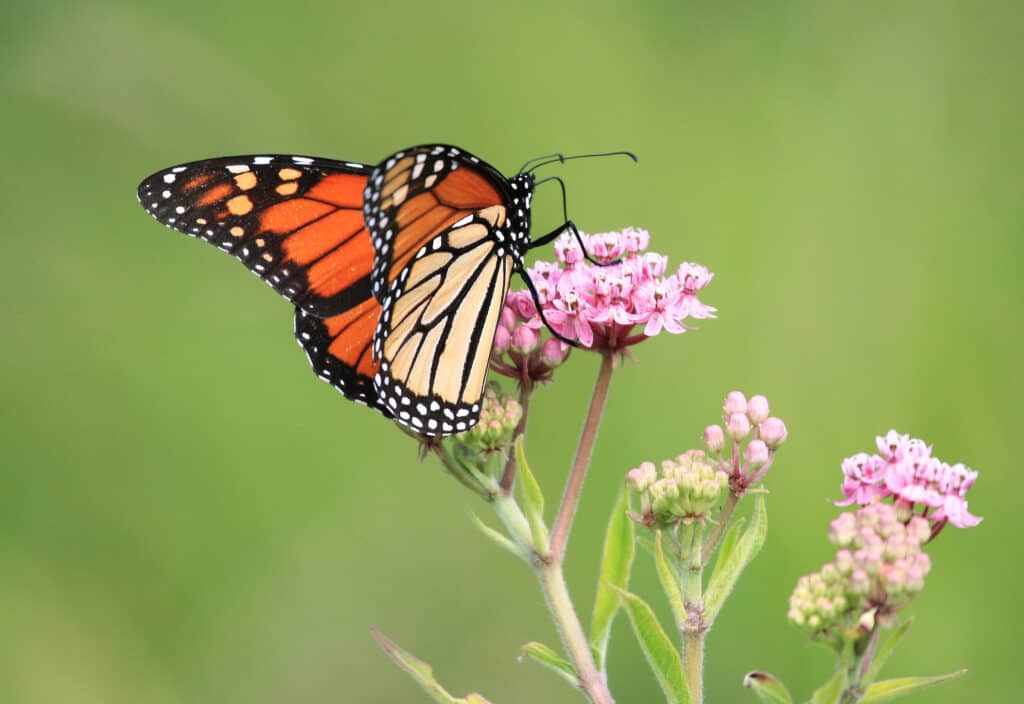
Monarch butterflies are crucial to the ecosystem of New Mexico’s tallest mountain.
©David Byron Keener/Shutterstock.com
Monarch butterfly
Danaus plexippus, or monarch butterflies, are known for their striking orange and black patterns. This makes them one of the most recognizable butterfly species in North America. These elegant creatures captivate both scientists and nature enthusiasts alike with their unique migratory behavior and intricate life cycle.
They are found throughout various regions of North America, including New Mexico’s tallest mountain. Monarch butterflies embark on an astonishing journey spanning thousands of miles each year. They undertake a remarkable multi-generational migration, traveling between breeding grounds in the United States and Canada to overwintering sites in Mexico.
The vibrant colors displayed by adult monarch butterflies serve as a warning to potential predators that they are toxic due to the ingestion of milkweed plants during their larval stage. This natural defense mechanism allows these delicate insects to safely navigate through diverse landscapes while avoiding predation.
Tarantula Hawk Wasp
The tarantula hawk wasp, a fascinating creature found in the rugged terrain of New Mexico’s tallest mountain, is a sight to behold. With its imposing size and striking appearance, this large black wasp commands attention as it gracefully hovers above the arid landscape. Its distinguishing feature lies in its vibrant orange wings, which boldly contrast against its dark exoskeleton.
What sets the tarantula hawk wasp apart from other insects is not just its formidable presence but also its unique hunting behavior. True to its name, this predatory insect has honed an extraordinary strategy for survival and reproduction. It seeks out tarantulas as hosts for their offspring—a remarkable feat that showcases nature’s intricate interplay between species.
When on the hunt, these stealthy creatures patiently stalk their eight-legged prey with utmost precision. They navigate through rocky crevices and arid shrublands with unwavering determination until they locate a vulnerable tarantula lair. Once within striking distance, the tarantula hawk wasp utilizes its powerful stinger to immobilize the spider swiftly yet skillfully.
The Amphibians
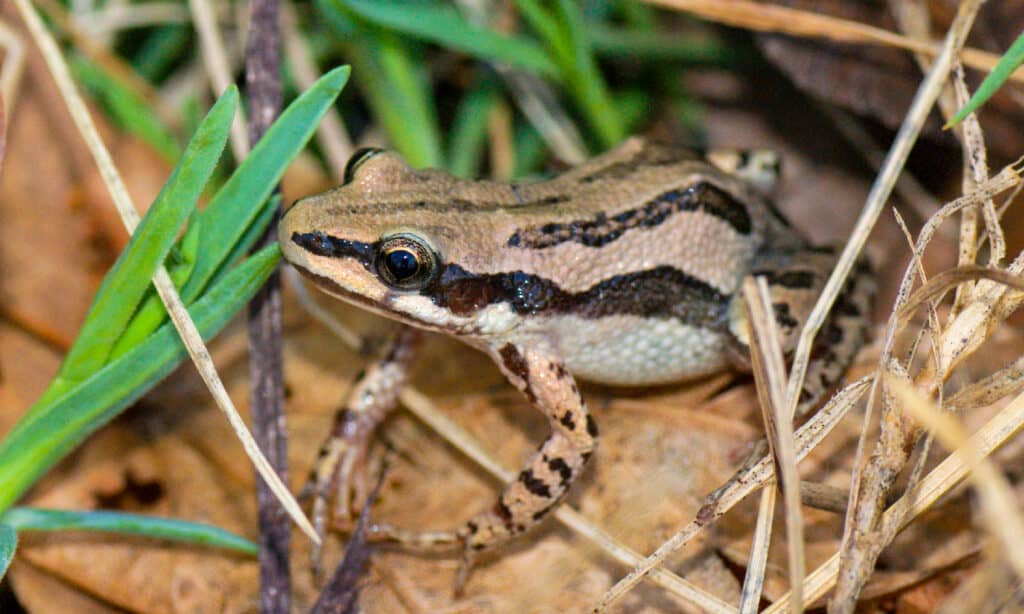
©Matt Jeppson/Shutterstock.com
Boreal Chorus Frog
Boreal chorus frogs are known for their enchanting melodies and captivating presence. They are small amphibians adorned with distinctive markings that add to their charm. These delightful creatures can typically be spotted in close proximity to water bodies, where they find solace in the tranquil surroundings.
The diet of these fascinating amphibians primarily consists of small insects and larvae. With their nimble tongues and lightning-fast reflexes, mountain chorus frogs skillfully snatch up unsuspecting prey. This ensures a steady supply of sustenance to fuel their energetic lifestyles.
While they may be petite in size, boreal chorus frogs possess an extraordinary ability to produce a symphony of calls that reverberates through the surrounding mountainous terrain. Their melodious choruses serve as both a means of communication among fellow frogs and as an alluring invitation to potential mates during the breeding season.
These remarkable creatures have adapted well to life amidst New Mexico’s tallest peaks. Their unique markings provide them with effective camouflage against the rugged landscape. This allows them to blend seamlessly into their natural habitat while evading predators lurking nearby.
The Fish
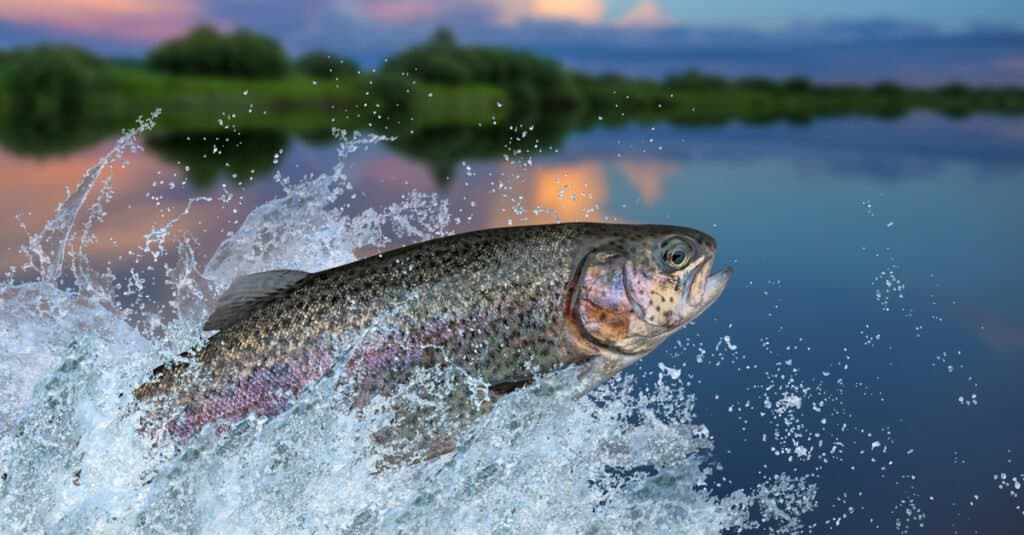
Oncorhynchus mykiss (rainbow trout) are commonly stocked in the lakes atop New Mexico’s tallest mountain.
©FedBul/Shutterstock.com
Rainbow Trout
Rainbow trout are widely recognized as popular game fish. They have captured the fascination of anglers and nature enthusiasts alike with their captivating, vibrant coloration. They are renowned for their stunning hues that shimmer like a rainbow under sunlight. These magnificent creatures are known to thrive in the pristine and icy waters of cold freshwater habitats.
Sporting a distinctive appearance characterized by a sleek body covered in iridescent scales. They range from vibrant pinks to rich oranges and deep greens. Each individual exhibits unique patterns that contribute to their undeniable allure. These flamboyant colors serve not only as visual marvels but also play crucial roles during courtship rituals. The males especially display mesmerizing hues to attract potential mates.
Cutthroat Trout
A cutthroat trout is a species of fish that is native to North America, particularly the western parts of the continent. It belongs to the Salmonidae family and can be found in various freshwater habitats such as rivers, streams, lakes, and ponds.
Known for its distinctive red or orange slash mark underneath its lower jaw, which resembles a “cut,” the cutthroat trout gets its name from this unique feature. This vibrant marking sets it apart from other trout species and helps in easy identification.
Cutthroat trout display remarkable adaptability by thriving in diverse environments ranging from cold mountain streams to larger river systems. They prefer clear waters with ample vegetation coverage for shelter and feeding opportunities. As opportunistic feeders, they have a varied diet consisting of insects, small fish, and crustaceans.
Ecology
All these animals contribute significantly to the ecosystem’s functioning. Their survival is dependent on each other, and they maintain the balance of nature. However, human activities pose a threat to these species. There is an urgent need for conservation efforts to protect them.
Suggestions for Hiking and Wildlife Viewing
When hiking Wheeler Peak, it is best to maintain a respectful distance from wildlife. Avoid feeding animals as it can disrupt their natural behaviors. The best times to view wildlife are early morning or late afternoon during the summer months. Remember, your behavior can significantly impact these animals’ survival, so be respectful of their wild home.
Summary of 16 Animals That Prowl Atop New Mexico’s Tallest Mountain
| Animal | Type | |
|---|---|---|
| 1 | Pika | Mammal |
| 2 | Marmot | Mammal |
| 3 | Elk | Mammal |
| 4 | Mule Deer | Mammal |
| 5 | Golden Eagle | Bird |
| 6 | Magpie | Bird |
| 7 | Canada Jay | Bird |
| 8 | Chickadee | Bird |
| 9 | Lewis’s Woodpecker | Bird |
| 10 | Western Diamondback Rattlesnake | Reptile |
| 11 | New Mexico Whiptail Lizard | Reptile |
| 12 | Monarch butterfly | Insect |
| 13 | Tarantula Hawk Wasp | Insect |
| 14 | Boreal Chorus Frog | Amphibian |
| 15 | Rainbow Trout | Fish |
| 16 | Cutthroat Trout | Fish |
The photo featured at the top of this post is © DrunkDriver / public domain – License / Original
Thank you for reading! Have some feedback for us? Contact the AZ Animals editorial team.






